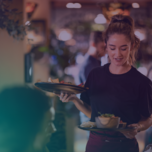The importance of food safety in hospitality businesses
The importance of food safety in the hotel and catering industry is undisputable in guaranteeing optimal service to consumers, and you must serve your guests food and drink that complies with the food safety regulations.
These food hygiene measures are even more important in the light of the recent health crisis, which has led to the introduction measures to prevent Covid19 from spreading.
Safe food handling is just one of the areas we cover in our complete hospitality compliance guide, but read on for more detailed information.
What is a food safety plan?
A food safety plan outlines a set of preventive measures and controls a business should carry out to guarantee food hygiene. It’s a tool for controlling the environment of the food production chain to ensure safety for consumers.
What does safe food handling entail?
As the UK government guidelines point out, to guarantee safe food handling your business must:
-
Make sure your food is safe to eat
-
Ensure you don’t add, remove or treat food in a way that makes it harmful to eat
-
Make sure the food is the same quality as you claim it is
-
Not mislead people in the way your food is packaged, labelled or marketed
-
Keep records about where you obtained the food, or “food traceability” records
-
Withdraw unsafe food and complete an incident report
-
Inform people of the reason food was withdrawn, with a poster or leaflet
-
Display your food hygiene rating (if you sell food directly to the public)
Make a HACCP food protection plan
The HACCP (Hazard Analysis Critical Control Point) is a European food hygiene regulation which requires food service businesses to assess the risks of food contamination and set up controls systems to prevent them, as well as how they’ll deal with any incidents that may occur.
The HACCP plan helps you ensure you keep your food safe from biological, chemical and physical food safety hazards. Each company must have its own HACCP plan, adapted to its activity and its product offering. To make a plan, you have to:
-
Identify any hazards that must be avoided, removed or reduced
-
Identify the critical control points (CPPs) – the points at which you need to avoid, remove or reduce a hazard in your work process
-
Set limits for the CCPs
-
Monitor the CCPs
-
Put things right if there is a problem with CCPs
-
Implement checks to make sure your plan is effective
-
Keep records – you’ll need to show them in case of an inspection
All of these points should be updated regularly when changes occur (introduction of new dishes and recipes, new methodologies in the kitchen, etc.).
You can create this document in paper format. But if your company has several sites and you want to ensure all teams use the same HACCP plan and automatically receive updates when they arise, then you should seriously consider digitising this process to guarantee safe food handling in your business.
Digitalising the HACCP plan to guarantee food hygiene
Compliance by Mapal is a food safety checklist software, you can digitise the HACCP plan and set up checklists so that your employees can perform each step easily and accurately. Within each checklist, they can also consult (by clicking on the "i" information button) the reasons why each point must be checked, which will help them understand and even explain each step the procedure in case of an inspection.
Due the importance of food safety, it’s essential to digitise your HACCP plan is essential, especially in the case of multi-site businesses, as each plan must be adapted to the activity carried out in each location.
And the good news is that head office departments have access to real-time and up to date food safety information and get HACCP compliance reports on the plans for each site.
Online training for safe food handling: customisable and regularly updated content
Your staff can only adhere to your plan if they have the right training and information. Failure to provide the right learning materials will jeopardise the safety of your customers. You’ll also be running the risk of serious penalties, damage to your reputation and the possible closure of venues.
Digital, mobile-first learning modules are the best way to ensure your team have access to regularly updated training content and to adapt the training of each employee according to their role (hygiene training for waiters, HACCP principles for kitchen staff, etc.). Flow Learning by Mapal offers an extensive library of bite-size compliance modules your team can complete at their own pace through our Mapal One app, including:
Food Safety Level 1: Exploring the most effective methods for controlling and preventing food contamination and food poisoning, learners will discover their role in ensuring food safety and will practise implementing these key actions. Perfect for front-of-house or occasional food handlers.
Food Safety Level 2: This resource will enable learners to follow the food journey. They will learn how to spot the safety risks and the causes of food contamination and food poisoning while also practising what they can do to control it. Additionally, they will brush up on prevention and cleaning techniques to help keep their kitchens clean and safe. Perfect for anyone involved in preparing, cooking and storing food.
Food Allergens: Your team will be able to tell their tree nuts from their sesame seeds with this guide to food allergens. Learners will discover the best ways to keep their guests safe. They’ll practice having this all-important conversation about allegrens with their guests and practise informing them of cross-contact controls
Please note:
Smartphones, tablets, touch screens and other electronic devices can harbour viruses and pathogenic bacteria. Recurrent cleaning and disinfection of these surfaces reduces the risk of contamination. So, it’s vital to include these devices in your daily cleaning and disinfection protocol.
4 key hygiene and food safety regulations for the catering sector
1. Cleanliness and disinfection
It’s vital to properly disinfect every surface that comes into contact with food every day: this rule also applies to floors, worktops and, of course, to all utensils that have been used. Utensils must be cleaned before and after use, and all equipment (refrigerators, extractor hoods, etc.) must be cleaned at least once a week.
Staff cleanliness and hygiene of staff are so paramount, especially those who handle food, including in relation to contract catering in schools, entertainment and event venues, companies, hospitals, etc.
2. Food handling rules
Safe food handling depends, largely, on the people who handle it: they are key to preventing and ensuring food safety in the kitchen, but they are also potential vectors of contamination.
Food handling training is essential and choosing a hospitality training software such as Flow Learning by Mapal, which enable you to customise and update each module. You can also your employees’ progress to ensure that each team member is well-informed to handle food safely.
3. Food traceability regulations
Food traceability regulations aim to minimise the risk of food safety incidents in any catering operation. In other words, food traceability means recording all the documents and information that prove the origin and route of any foodstuff.
For a company in the hotel and catering industry, this really is the only way to effectively identify if a product is not fit for consumption.
Some of things you should keep records of include:
- The nature, volume and quantity of the product
- Product description
- Name and contact details of the supplier
- The batch number
- Shelf life or Best Before Date
- The date of receipt of the product
To do this, you will need to ensure you keep records of labels, preparation sheets or delivery notes relating to these foodstuffs for a certain period of time.
By digitising the information with a restaurant inventory management solution such as Easilys f&b by Mapal, you’ll be able to trace the batches throughout the chain, ensuring your customers’ safety and complying with applicable legislation. The app means you can monitor and update food traceability in real time – invaluable in the event of targeted withdrawals or recalls, and also guarantees transparency of consumer-targeted information.
4. Allergen labelling
Every employee who comes into contact with food must be aware of the list of allergens. Failure to comply with allergen-related food safety standards could lead to severe penalties, putting your customers at risk, some with grave consequences such as those that led to the introduction of Natasha’s Law in 2016.
It’s vital to ensure your team are allergen-trained, not only for safe food handling but also to and know how to answers your customers’ concerns and questions. Flow Learning by Mapal offers short and engaging learning modules your team can complete quickly and, on the go, to ensure everyone is prepared to protect your customers, and your brand reputation.
There are 14 allergens that must be clearly labelled on your food products and menus:
- Cereals containing gluten
- Crustaceans
- Celery
- Eggs
- Mustard
- Fish
- Nuts
- Peanuts
- Sulphur dioxide and sulphites in concentrations of more than 10 mg/kg or 10 mg/l
- Soya
- Celery
- Sesame seeds
- Lupins
- Milk
If you would like to reinforce the importance of food safety in your organisation and discover more about how Mapal-OS can help you optimise your food hygiene processes, talk to our team.





